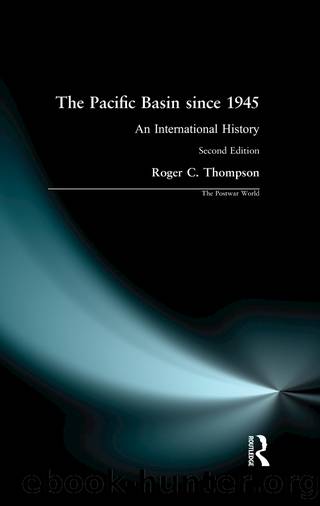The Pacific Basin since 1945 by Roger C. Thompson

Author:Roger C. Thompson [Thompson, Roger C.]
Language: eng
Format: epub
Tags: History, Australia & New Zealand, Political Science, International Relations, General
ISBN: 9780582021273
Google: dO4BvgAACAAJ
Publisher: Longman
Published: 1994-01-15T16:07:49+00:00
Melanesians under Indonesian rule
In 1969 Indonesia organized the take-over of the Melanesian territory of Irian Jaya, called West Papua by indigenous nationalists. When Indonesia took control of the territory on 1 May 1963 to prepare it for a UN supervised self-determination plebiscite in 1969, as set out in the agreement with the Netherlands, every effort was made to obliterate Papuan nationalism and culture. The process started on 2 May with a huge bonfire of symbols of Papuan life, school textbooks and West Papuan flags in the central square of the principal city of Jayapura, which was located on the north coast close to the PNG border. The next day a Papuan council elected under Dutch rule was replaced by an appointed Regional People's Assembly to operate on Guided Democracy principles. The first governor was a Papuan, Eliezer Bornay, who later said, after he was removed from office in 1964, that he first thought there would be a genuine free choice for his people in 1969. But such hopes were snuffed out by 'numerous brutalities, thefts, torture, maltreatment, many things that had not happened before'.65 The result was the emergence in 1965 of Papuan armed resistance led by Arfak tribesmen, some of whom had been trained by the Dutch Papuan Volunteer corps. They used weapons surviving from the Second World War as well as traditional bows and arrows and called themselves Organisasi Papua Merdeka (OPM) (Free Papua Movement). Indonesian responses to the rebellion included airforce strafing and army burning of Papuan villages and mass executions. The act of'free choice' was carried out in 1969 by 1,025 Papuan 'representatives'. They were carefully trained to vote unanimously on behalf of 800,000 Papuans to 'remain with Indonesia' in front of UN representatives and foreign diplomats, who duly declared that the farce was a legitimate expression of the will of the Papuan people.66
65 C. Budiardjo and L.S. Liong, West Papua: The Obliteration of a People (revised edition, London 1984), 25.
66 Ibid., ch. 2. Nonie Sharp, The Rule of Sword: The Stoiy of West Irian (Malmesbury 1977), 15-23. Robin Osborne, Indonesia's Secret War: The Guerilla Struggle in Irian Jaya (Sydney 1985), ch. 1.
The OPM did not give up its struggle, even though it suffered from disunity, a paucity of firearms and mass reprisals by the Indonesian army assisted by US-supplied helicopter gun ships. The OPM had neither the cohesiveness, the degree of military training nor the many modern weapons possessed by Fretilin in East Timor. However, the OPM was assisted by a much vaster mountainous and jungle clad terrain. The Indonesian government soon realized that large force action was counter productive, since villagers were driven further into the mountains, where they were much harder to control and where the guerrillas had plenty of hiding places. So from 1973 a strategy was introduced to use security agencies in the style of dictatorial Latin American governments to detain or kill educated Papuans suspected of OPM leanings and thus deprive the organization of its leadership. Such tactics increased villagers' hostility to the brutal administration.
Download
This site does not store any files on its server. We only index and link to content provided by other sites. Please contact the content providers to delete copyright contents if any and email us, we'll remove relevant links or contents immediately.
Harry Potter and the Goblet Of Fire by J.K. Rowling(3040)
Never by Ken Follett(2878)
Shadow of Night by Deborah Harkness(2718)
Ogilvy on Advertising by David Ogilvy(2682)
Zero to IPO: Over $1 Trillion of Actionable Advice from the World's Most Successful Entrepreneurs by Frederic Kerrest(2388)
The Man Who Died Twice by Richard Osman(2296)
Machine Learning at Scale with H2O by Gregory Keys | David Whiting(2283)
Book of Life by Deborah Harkness(2263)
How Proust Can Change Your Life by Alain De Botton(2259)
My Brilliant Friend by Elena Ferrante(2221)
0041152001443424520 .pdf by Unknown(2219)
The Tipping Point by Malcolm Gladwell(2204)
How to Pay Zero Taxes, 2018 by Jeff A. Schnepper(2098)
Will by Will Smith(2040)
Purple Hibiscus by Chimamanda Ngozi Adichie(1981)
Hooked: A Dark, Contemporary Romance (Never After Series) by Emily McIntire(1950)
Borders by unknow(1785)
Rationality by Steven Pinker(1764)
Daughter of Smoke and Bone by Laini Taylor(1742)
